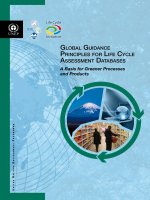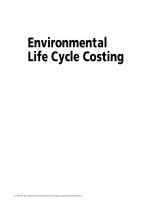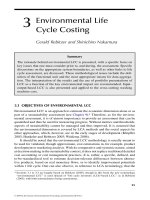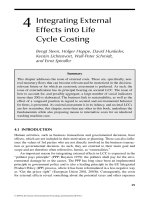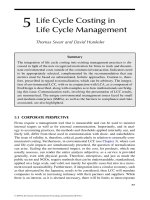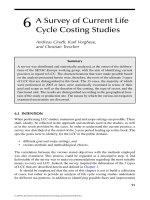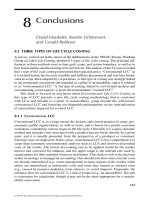Life cycle costing for cleanroom construction
Bạn đang xem bản rút gọn của tài liệu. Xem và tải ngay bản đầy đủ của tài liệu tại đây (1.11 MB, 161 trang )
LIFE CYCLE COSTING FOR CLEANROOM
CONSTRUCTION
YANG LIU
(B.ENG. (CIVIL), SHANGHAI JIAOTONG UNIVERSITY)
A THESIS SUBMITTED FOR
THE DEGREE OF MASTER OF SCIENCE (BUILDING)
DEPARTMENT OF BUILDING
NATIONAL UNIVERSITY OF SINGAPORE
2003
ACKNOWLEDGEMENTS
I wish to express my profound gratitude to my supervisor, Associate Professor Gan
Cheong Eng, for his invaluable guidance and encouragement during the course of
research. I also thank him for his advice, comments and suggestions when analyzing the
results.
I am immensely grateful to Mr. David Ong, Bovis Lend Lease Pte Ltd, for his advice on
the research direction and for his kind recommendation to cleanroom professionals, for
whom I appreciate their participation to my interview requests. Based on their abundant
experiences, their valuable views do me a great favor in the completion of this
dissertation.
I would like to thank Assistant Prof. Wang Shou Qing, who extended guidance from time
to time on the research problems, help me improve and validate the research strategy and
gave me many useful comments.
I also wish to express my appreciation to Mr. Raymond Wong, Sunny Li, Choo Lip Sin,
Andi Dulung, Frances Ong-Loh, Ranjith and other members in the Life Cycle Costing of
High-Tech Building Research Team for their suggestions and advice. My friends, Jiang
Hongbin, Zhu Ming, Zhang Meiyue, Wang Wei, Shi Yan, Guan Feng, Gong Nan, Xie
Yongheng, Li Yan, Zhang Ji, Tang Yanping for making those stressful days tolerable and
being there every time when I needed help.
Most importantly, I would like to thank my Dad and Mum for their unconditional love and
encouragement.
Yang Liu
- i-
Table of Contents
Page
ACKNOWLEDGEMENTS
i
SUMMARY
vi
LISTS OF TABLES
viii
LIST OF FIGURES
ix
Chapter 1
INTRODUCTION
1
1.1
Background
1
1.2
Research objectives
5
1.3
Scope of research
5
1.4
Structure of dissertation
6
LITERATURE REVIEW
9
Cleanroom
9
2.1.1
Definition of cleanroom
9
2.1.2
Basic parameters to describe cleanroom
9
2.1.2.1 Application of cleanroom
10
2.1.2.2 Location of cleanroom
11
2.1.2.3 Area of cleanroom
11
2.1.2.4 Class of cleanliness
12
2.1.2.5 Internal environment parameters
14
2.1.2.6 Basic parameters of air handling systems
16
2.1.2.7 Airflow type and velocity
17
2.1.2.8 Type of layout
19
2.1.2.9 Type of air ventilation
21
2.1.2.10 Type of air return
22
Cleanroom components
22
2.1.3.1 Cleanroom floor
22
2.1.3.2 Filter ceiling
23
Chapter 2
2.1
2.1.3
-ii-
2.1.4
2.2
2.1.3.3 Partition walls
24
2.1.3.4 Make-up air system
24
2.1.3.5 Recirculation air system
26
2.1.3.6 Process exhaust system
27
2.1.3.7 Cooling system
28
2.1.3.8 Heating system
29
2.1.3.9 Other components
29
Research on cleanroom cost efficiency
29
Life Cycle Costing
32
2.2.1
Background
32
2.2.2
Definitions of life cycle cost and life cycle costing
33
2.2.3
Life cycle cost analysis and procedure
34
2.2.4
Data for life cycle costing
36
2.2.5
Application in the building industry
40
2.3
Methods for cost modeling
44
2.4
Summary
49
RESEARCH METHODOLOGY
50
3.1
Research design
50
3.2
Interview
51
3.3
Framework of cleanroom life cycle cost
53
3.4
Questionnaire survey
55
3.4.1
Survey method
56
3.4.2
Questionnaire design
57
Chapter 3
3.5
3.4.3 Respondents
59
Modeling method
60
3.5.1
60
Correlation analysis
3.5.2 Regression modeling
62
3.5.3 Model testing
63
3.5.3.1 F-test for the overall model
63
3.5.3.2 t-test for regression coefficients
65
-iii-
3.6
3.7
3.5.4
Backward elimination
67
3.5.5
Verification of regression assumptions
68
Calculation of life cycle cost
70
3.6.1
Establish common assumptions and parameters
70
3.6.1.1 Real discount rate
70
3.6.1.2 Study period
73
3.6.1.3 Escalation rates
74
3.6.1.4 Salvage value
74
3.6.1.5 Current dollars and constant dollars
75
3.6.1.6 Present time
75
3.6.2
Identify and estimate relevant costs/time occurrences
76
3.6.3
Compute life cycle cost at present time
76
3.6.4
Convert life cycle cost to value on a common base
78
Summary
78
DATA ANALYSIS AND RESULTS
79
4.1
Response rate
79
4.2
Sample analysis
79
4.2.1
Factors of identical values
80
4.2.2
Cleanroom area and cleanliness level
80
4.2.3
Factors of numerical values
82
4.2.4
Factors of categorical values
84
Chapter 4
4.3
Profile analysis
85
4.4
Calculation of life cycle cost
85
4.5
Selection of explanatory variables
89
4.6
Correlation analysis
91
4.7
Model construction
94
4.7.1
Backward elimination regression analysis
2
94
4.7.2
Multiple coefficient of determination, R
98
4.7.3
Analysis of variance
100
4.7.4 Statistical inference for regression coefficients
101
-iv-
4.8
Model verification
102
4.9
Discussion of results
110
4.10
Summary
112
CONCLUSION
113
5.1
Summary
113
5.2
Findings
115
5.3
Research limitations
116
5.3.1
Limitations of research methodology
116
5.3.2
Limitations of results
117
Chapter 5
5.4
Research contributions
118
5.5
Recommendations for further work
120
BIBLIOGRAPHY
121
APPENDICES
Appendix 1
Questionnaire
130
Appendix 2
Data collection of target projects
136
Appendix 3
Calculation of life cycle costs
142
-v-
SUMMARY
Cleanrooms are needed in many manufacturing processes that range from semiconductor
manufacturing to life sciences. As mechanically intensive facilities, a cleanroom
consumes large amount of energy to maintain its defined environment, which in turn
requires high capital and operation cost. This has made cost-efficiency an important
consideration in cleanroom design. Thus, it is more logical to consider the life cycle cost
rather than only the initial cost when evaluating a cleanroom project.
This study is an attempt to establish a cost estimation model for a cleanroom project from
the view of its whole lifespan, i.e., a life cycle cost model. It is hypothesized that the life
cycle cost of a cleanroom depends on certain design parameters. From the results of a
literature review and interviews, significant design parameters are identified. Major cost
items are figured out, cleanroom components are ranged, and subsequently, a framework
of cleanroom life cycle cost is established for the convenience of data collection.
A questionnaire survey is conducted among available cleanroom contractors in Singapore.
12 sample cleanroom projects are selected for data analysis. Through frequency analysis
and correlation analysis, certain design parameters are removed from regression analysis,
for exhibiting identical values or high correlationship. Regression analysis further reveals
that six parameters contribute the most to the life cycle cost, namely, floor area,
corresponding cleanliness class, make-up air volume, type of air return, type of air
ventilation and type of chiller.
As a result of regression analysis, the internal relationship between these six significant
parameters and cleanroom life cycle cost are presented accordingly. Through analysis of
variance and plot of residuals, the linear regression model established shows a good fit
and no violation is found for basic regression assumptions. Hence, the model is proven to
be reasonable and acceptable.
-vi-
Based on the model, the influence of each design parameter on cleanroom life cycle cost is
analyzed. The result shows that the adoptions of a smaller cleanroom area, a lower
cleanliness level, a less make-up air supply, an air ventilation using pressurize circulation
fans, an air return through vents in wall or an air-cooled chiller would all result in lower
life cycle cost of such kinds of cleanroom design.
Final research findings and the regression model obtained would definitely contribute to
cleanroom investment budgeting, design alternatives comparison and decision-making.
The survey methodology adopted and cost framework developed through understanding of
the mechanisms of life cycle would be useful for the development of cleanroom costing
database. Finding of significant cost factors would also be beneficial for further studies on
cost efficiency of cleanroom projects.
-vii-
List of Tables
Page
Table 2.1
Federal Standard 209(A to D) Class Limits
13
Table 2.2
A comparison of major classification standards
14
Table 2.3
Air velocity in cleanrooms
19
Table 3.1
Calculation of Real Discount Rates from Year 1977 to Year 2000
72
Table 4.1
Factors of identical values
79
Table 4.2
Distribution of cleanroom area
80
Table 4.3
Distribution of average filter coverage rate
80
Table 4.4
Filter coverage for desired cleanliness classification
81
Table 4.5
Distribution of cooling load
81
Table 4.6
Distribution of airflow velocity
82
Table 4.7
Distribution of make-up air volume
82
Table 4.8
Distribution of recirculation air volume
82
Table 4.9
Distribution of exhaust air volume
82
Table 4.10
Distribution of air ventilation type
83
Table 4.11
Distribution of air return type
83
Table 4.12
Distribution of filter type
83
Table 4.13
Distribution of chiller type
84
Table 4.14
Calculation of life cycle cost
85
Table 4.15
Comparison of LCC calculation at a higher discount rate
87
Table 4.16
Initial list of variables considered in the cost model
90
Table 4.17
Definition of dummy variables
91
Table 4.18
Correlation matrix for 12 independent variables
92
Table 4.19
SAS output of analysis of variance
99
Table 4.20
SAS output of parameter estimates
101
Table 4.21
Model output statistics
102
-viii-
List of Figures
Page
Figure 2.1
Vertical laminar flow cleanroom
17
Figure 2.2
Horizontal laminar flow cleanroom
17
Figure 2.3
Turbulent flow cleanroom
18
Figure 2.4
Mixed flow cleanroom
18
Figure 2.5
“Ballroom” cleanroom
19
Figure 2.6
“Tunnel” cleanroom
20
Figure 2.7
Minienvironment
21
Figure 2.8
A central system air handling unit
26
Figure 2.9
Breakdown of life cycle costs of ownership of a constructed asset
34
Figure 2.10
Harvey’s life cycle costing procedure
35
Figure 3.1
Framework of cleanroom life cycle cost
54
Figure 3.2
F-distribution
65
Figure 3.3
t-distribution
66
Figure 4.1
Observed values versus predicted values of LCCYear 1998
100
Figure 4.2
Plot of the standardized residuals versus the predicted values
104
Figure 4.3
Plot of the standardized residuals versus variable CA
105
Figure 4.4
Plot of the standardized residuals versus variable AFC
105
Figure 4.5
Plot of the standardized residuals versus variable MAV
106
Figure 4.6
Plot of the standardized residuals versus variable TAV2
106
Figure 4.7
Plot of the standardized residuals versus variable TAR
107
Figure 4.8
Plot of the standardized residuals versus variable TC
107
Figure 4.9
Normal probability plot of the standardized residuals
109
-ix-
Chapter 1 – Introduction
Chapter 1
1.1
Introduction
Background
Nowadays, the need for more and better cleanrooms has expanded dramatically with the
development of high technology industries. This increased demand can be attributed to a
greater number of wafer fabrications, research laboratories, pharmaceutical facilities,
hospitals, and all kinds of new product manufacturing plants requesting their operations to
be in special environments to prevent contamination. Since their processes or products are
sensitive to microscopic matters such as dust, air-borne particles, electrostatic discharges,
chemical contamination, electromagnetic fields and oxygen, cleanrooms are required,
designed and built with controls of these microscopic matters and common environmental
factors like temperature, relative humidity, and vibration to achieve this special
environment.
The growing need for cleanroom is most notable in the semiconductor manufacturing
industry. Incredible progress in this field has given rise to higher demands and more
stringent requirements on cleanroom facilities to provide suitable manufacturing space. As
reported by McIlvaine Company (August 2002), the semiconductor industry would
rebound and account for 37% of cleanroom sales in Year 2006, up from just 25% in Year
2002. The report also stated that, although sales of cleanrooms would be less than $2.7B
- 1-
in Year 2002, the market would achieve double-digit growth over the next four years, and
sales would reach greater than $4B in Year 2006.
Moreover, other types of research laboratories create an increasing demand especially on
comparatively smaller cleanrooms. Among them the Micro-/Nano-technology research
laboratories are the most pre-dominant ones. Besides the medical and biotech laboratories,
newly booming life sciences research laboratories are taking an important place and
making the cleanroom design more specialized with their complex requirements. Modern
cleanroom technology is therefore being pushed to reach a higher level with the rapid
development of these related industries.
In recent years, the cost of a cleanroom keeps skyrocketing. Commonly used capital
estimates can range from US$1,800 per square foot to as much as US$4,000 per square
foot of process cleanroom space. This cost includes the cleanroom (building enclosure,
cleanroom walls, floors and ceilings) and the supporting utility systems (high purity gases
and liquids, effluent treatment) (Goldstein, 2002). “A Class 10 environment typically costs
about US$2,000 per square foot to build and US$1 million a year to operate,” said Lloyd
Crosthwait, a cleanroom expert at the University of Texas at Dallas’ NanoTech Institute
(Zaragoza, 2002).
Cleanrooms, as mechanically intensive facilities, require a large amount of power and
other kinds of energy to maintain the defined environment. Air conditioning, along with
clean air handling and circulation, account for more than 60% of the power required to
operate a cleanroom (Takenami, 1989). The large power consumption has made energy- 2-
efficiency an important consideration in the cleanroom design. By choosing appropriate
equipment with high efficiency, like those for minimizing the airflow rate and exhaust air
volume, and adopting the mini-environment layout, scientists have found more feasible
ways to improve its cost-efficiency.
Apart from the high-energy cost, considerable costs relating to cleaning and maintenance
also happen during the operation period. Since all these costs are continuously occurring,
the accumulated sum of operation cost at the end of the cleanroom lifetime would be
added on to its initial cost. Therefore, when evaluating a cleanroom project, it is more
reasonable to consider the whole life cycle cost rather than the initial cost merely. The life
cycle cost here refers to the total facility-related costs over the lifetime of a cleanroom. It
can be expressed as a discounted value at a certain point of time by applying the present
value technique.
So far, there is much guidance about how the life cycle cost should be modeled and
calculated (Flanagan and Norman, 1983). Some attentions have been focused on the need
to optimize the sum of capital and operation cost (Kooren, 1987). However, much of the
literature has concentrated on the mechanics of the calculation, especially the application
of discounted cash flow. As a result, practical solutions to determine accurate life cycle
cost remain untreated. One principal difficulty is the absence of reliable data (AL-Hajj and
Horner, 1998). In view of such difficulty, it is meaningful to establish a minimal model to
evaluate cleanroom life cycle cost based on a practical study of available cleanroom
projects.
- 3-
The quality, performance and total installation cost of a cleanroom project is defined
during the first two design activities, i.e. programming or scope definition and conceptual
design (Wiegler, 1997). This statement implies that a significant relationship exists
between the initial design and the final cost of acquiring, owning and operating facilities
over the economic life of a cleanroom. Research is conducted to establish a feasible model
to define the relationship between cleanroom life cycle cost and those critical variables of
a cleanroom design.
Since owners want the cleanrooms to be constructed in less time, for less money, with a
higher performance level, and a lower future running cost, the problem confronting most
owners nowadays is a lack of a standard by which the performance of a cleanroom project
can be gauged. By attempting to identify and quantify all the significant costs involved in
the whole life of a cleanroom, and presenting the relationship of its life cycle cost with its
critical characteristics, the cost model set up in this study would also contribute to the
establishment of such a standard in the cost performance aspect.
The research findings and the cost model set up would contribute to better decisionmaking and budgeting by cleanroom facilities owners, designers and constructors. Also in
this research, the methodology used and cost framework developed through understanding
the mechanism of a cleanroom life cycle would be useful in establishing a new protocol
for the collection of statistics and application of data, and the development of database for
different product demands.
- 4-
1.2
Research objectives
With the increasing high cost of cleanroom projects due to the increasing tool cost, the
complexity of advanced technology facilities, and the substantive expense to maintain
cleanrooms operating regularly at the required cleanliness level, an investment budget in
terms of the total life cycle cost for a cleanroom project is necessary and should be
evaluated at early stage in the feasibility study. To date, not only is there no complete
study on total cost over the entire lifetime of cleanroom, but also no standard cost system
available to estimate, verify and project the cost of a cleanroom construction. In order to
obtain an accurate costing, it is necessary to establish a detailed cost framework based on
at least the critical parameters of the facility.
The objectives of the research in this dissertation are:
To establish a rational cost framework for cleanroom by introducing the concept of
life cycle costing to the cleanroom projects.
To identify those significant parameters that would contribute the most to the
cleanroom life cycle cost.
To develop a simple cost model for estimation of the cleanroom life cycle cost.
1.3
Scope of research
Projects investigated in this study comprise of new construction cleanroom projects with
the following characteristics:
- 5-
•
Small-scale foundry or laboratory projects
•
Constructed by local cleanroom contractors
•
Completed after Year 1998
The study concentrates on small cleanrooms. Cost considerations for large cleanrooms are
different from small ones because the design principles vary much (see Section 2.1.2.3).
Local cleanroom contractors are sourced as data suppliers in the survey because there is
no public source for such information. To get updated research results, samples selected
are confined to those completed after Year 1998.
In the study, the scope of the life cycle cost analysis covers only the initial cost and the
operating cost of typical cleanroom facilities. Those income and cost items brought by the
production process are not considered. As to the facility administration cost, which has
little share in the cost pie of a cleanroom project, it is also excluded from the study
according to the principle of importance.
1.4
Structure of the dissertation
The structure of this dissertation is as follows:
Chapter 1: Introduction
This chapter provides a brief explanation of the purpose of the research. It states the
background of reasons why the study is needed and also defines the scope of the research.
- 6-
Chapter 2: Literature Review
This chapter introduces the basic knowledge on both cleanroom and life cycle costing.
Details include definitions, classifications, basic design parameters and subsystems of the
cleanroom as well as definitions, activities and data requirements of life cycle costing.
Previous works regarding the cost efficiency of cleanroom, the application of life cycle
costing in construction industry, and cost modeling methods used for management of
construction projects are also reviewed in this chapter.
Chapter 3: Research Methodology
This chapter presents the overall research design. Results of the interviews are discussed,
the framework of cleanroom life cycle cost is set up and the procedure of questionnaire
survey is highlighted. Methods for regression analysis and model testing are discussed.
Important parameters that should be considered in life cycle cost calculation as well as the
life cycle cost equation adopted are also presented in this chapter.
Chapter 4: Data Analysis and Results
This chapter presents the response of questionnaire survey as well as the whole process of
cleanroom life cycle cost modeling. Samples are analyzed and the independent variables
are identified for the regression analysis. A linear regression model based on certain
significant variables is built and tested. The residual plots of the model are checked to
ensure that no violation to regression assumptions could be found. Finally, the analysis
results are discussed.
- 7-
Chapter 5: Conclusion
This chapter concludes this study. Research findings are summarized; limitations in
research methodology and results are discussed respectively; contributions to both the
knowledge and industry-practical implications are indicated; recommendations for future
work are also highlighted.
- 8-
Chapter 2 – Literature Review
Chapter 2
2.1
Literature Review
Cleanroom
2.1.1 Definition of cleanroom
In US Federal Standard 209E (1992), a cleanroom is theoretically defined as:
‘A room in which the concentration of air borne particles is controlled and which contains
one or more clean zones.’
Summarized by Engineering Services Division, Davis Langdon & Seah (2000), the term
cleanroom, in most practical applications, refers to an area with controlled cleanliness,
environment and access with the following requirements:
•
Removal of air borne particles such as dust and pollen;
•
Prevention of generated particles;
•
Temperature and humidity control;
•
Adjustment of pressure;
•
Exhaust of harmful gases.
2.1.2
Basic parameters to describe cleanroom
The performance of a cleanroom may be judged by the quality of control concerning
particulate concentration and dispersion, temperature, relative humidity, pressure drops,
-9-
vibration, noise and airflow pattern (Naughton, 1990). The objective of a good cleanroom
design is to provide control of these parameters with the highest quality and conformity to
design requirements while maintaining reasonable construction and operation costs.
Requirements on above-mentioned technical parameters decide the design of cleanroom
and would subsequently influence the final cost for cleanroom construction and operation.
Besides, parameters such as the application, the location, the construction scale, and the
layout design of proposed cleanroom are also very important parameters to be considered
in project evaluating. Based on these basic parameters, the desired model could be
structured. Below is a summarization of these basic parameters:
2.1.2.1
Application of cleanroom
The appearance of cleanroom could be traced back to more than 100 years ago as a
measure of infection control in hospitals. The development of the first cleanroom for
industry manufacturing started during the Second World War in the United States and the
United Kingdom in an attempt to improve the quality and reliability of manufacture of
instrumentation used in guns, tanks, and aircraft by the control of particles in a production
environment (Whyte, 1999).
Nowadays, the use of cleanrooms as foundries and laboratories has mushroomed and a
large range of products such as computers, CD players, lasers, navigational systems,
medicines, medical devices, convenience foods and various products of the new
technologies, require a control of contamination that is only available in cleanroom. The
-10-
most prominent applications could be summarized in five major fields as semiconductor,
electronics, pharmaceutical, medical device and food processing (Anonymous, 2001).
2.1.2.2
Location of cleanroom
Most of the advanced cleanrooms are located in developed countries because of the wide
existence of high-tech intensive industries and related research institutes. Nano/ Microtechnology wafer fabs, which represent the largest share of cleanroom applications, could
be found only in countries like US, Europe, Japan, Taiwan, Korea, Singapore before. In
recent years, as a demand of reducing production cost, and due to the willingness to
develop their own technology, more and more large-scale fab cleanrooms appear in
developing countries. Such trends are the most notable in China since the last decade.
According to Mcilvaine Report (2002), the top 10 purchasers of cleanroom hardware in
Year 2006 would be the United States, Japan, South Korea, Taiwan, China, UK, Germany,
Thailand, Malaysia and France. By then, the combined demand of South Korea and
Taiwan's would exceed Japan tremendously.
Due to the geography and climate difference, the design of cleanroom is also different
from country to country. For example, the heating systems, which are essential in Europe
and Japan, are seldom considered in tropical countries like Singapore.
2.1.2.3
Area of cleanroom
Historical rates of building construction and operation cost are usually expressed in unit
area price and used as important index for project evaluating. Classified by function,
-11-
cleanrooms are usually composed of process area and service area (Chang and Sze, 1996).
Areas of different cleanliness level are divided by partitions.
There are two basic styles of cleanroom, namely, foundry and laboratory. The former is
for manufacturing whereas the latter is for research. The area of a large-scale foundry
cleanroom such as a wafer fab usually exceeds 10K square meters, whereas that of a
small-scale foundry or laboratory cleanroom is only range from less than one hundred to
several thousand square meters.
Most of the large-scale foundry cleanrooms are integrated with their building enclosure
structures, which become part of the cleanroom functions. For example, a typical wafer
fab cleanroom is actually a whole building of three levels, where the production area is
arranged at 2nd floor, while the 1st and 3rd floor serve as return and supply air plenum
respectively. As for small cleanrooms, they are constructed within an existing building
and have their own enclosure system. As such, the design considerations of large-scale
foundry cleanrooms differ very much from the small-scale ones.
As the first attempt in the research of cleanroom life cycle cost, this study is concentrated
on small-scale foundry and laboratory cleanrooms.
2.1.2.4
Class of cleanliness
The class of cleanliness represents the quality of control of particulate size and
concentration in a cleanroom. The classification method suggested in the earlier versions
-12-
A to D of US Federal Standard 209 is the most easily understood and most universally
applied. In this old standard, the number of particles equal to and greater than 0.5µm is
measured in one cubic foot of air and this count is used to classify the room. A much
changed version E was published in 1992. However, because of its simplicity and the
universal use of the older FS209 versions, the old standard will not be superseded in a
short time. For the same reason, it is also adopted in the study. The classifications given in
the earlier FS209 A to D versions are shown in Table 2.1.
Table 2.1 Federal Standard 209(A to D) Class Limits
MEASURED PARTICLE SIZE (MICROMETERS)
CLASS
0.1
0.2
0.3
0.5
5.0
1
35
7.5
3
1
NA
10
350
75
30
10
NA
100
NA
750
300
100
NA
1,000
NA
NA
NA
1,000
7
10,000
NA
NA
NA
10,000
70
100,000
NA
NA
NA
100,000
700
Source: Cleanroom Design, Whyte 1999
Many other cleanroom classification standards are based on the various editions of FS209.
Some countries completely adopted FS 209, while others made their own national version,
similar to FS209. Due to the different name of the classes in different countries, care must
be taken so as not to mix up the standards. The new ISO Classification Standard 14644-1
was published in Year 1997 for international use of cleanroom standards. A comparison of
these standards is summarized in Table 2.2.
-13-

